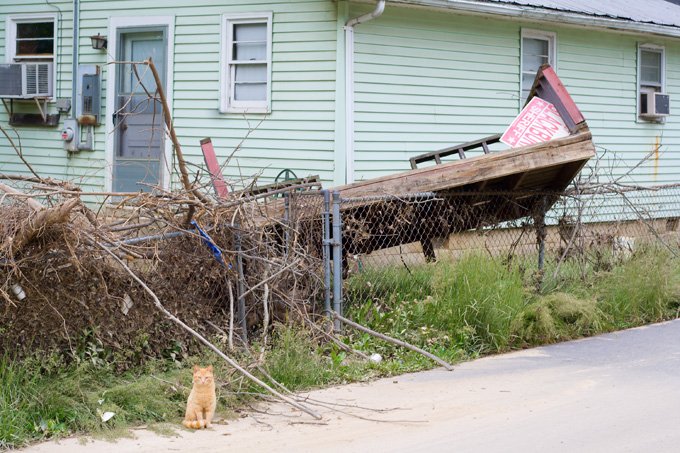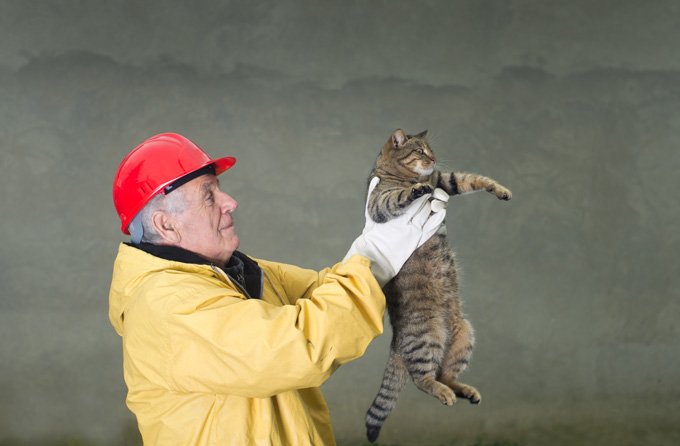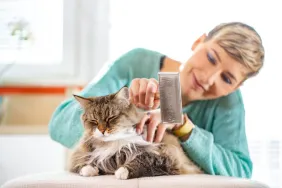Many people put off preparing for emergency situations because it’s uncomfortable to think about. Who wants to spend time thinking about what would happen if their cat was injured or trapped in a house fire? But the fact is, preparing for such things will greatly increase the chances that your cat will make it out safe and healthy (albeit a bit shaken up).
September is National Disaster Preparedness Month, which makes it the perfect time for you to spend some time thinking about what would happen to you and your cat in the event of an injury or emergency, and what you can do to stack the odds in your favor.
Prepare A First Aid Kit
If your cat has been injured, having a Cat First Aid Kit can help keep your cat safe and more comfortable until you’re able to access a veterinarian. Pet-specific First Aid kits can be found in most pet stores. You can also add pet specific items to your existing human First Aid kit or develop your own, storing the items in a waterproof container.
We have an excellent list of 10 Must Have Items For Your Cat’s Emergency Kit. It may seem like bigger is better, but keep in mind that a kit with so many components will only be useful if you know how to use each of them. In a moment of crisis, an overwhelming kit could put your cat in more danger.
The Humane Society suggests a more basic (but still effective) kit. It has everything you may need until you can find professional help.
Note that, in addition to the medical supplies traditionally found in a First Aid kit, your cat’s kit should also include a list of important phone numbers (your veterinarian, a 24-hour emergency clinic, a poison control hotline) and a copy of your cat’s medical records.
Prepare A Comfort Kit
A comfort kit will contain your cat’s basic needs, in case you need to flee your home quickly. This kit should include:
- A few days worth of food. Don’t forget to include a can opener, if the food requires one.
- Bowls for food and water
- A litter box and litter
- Any medications your cat requires (pay attention to expiration dates)
- Bedding
- Anti-stress remedies. Your local pet store should have several options.
- Many animal welfare and rescue organizations suggest keeping pillowcases accessible as a transportation alternative if you aren’t able to crate your cat.
Make The Crate Familiar
Emergency situations can be made considerably less stressful for both you and your cat if she is able to see her crate as a safe and familiar space. To help create a positive association, don’t hide her cat crate or carrier away in a closet to only bring out for trips to the veterinarian. That will only force her to associate the crate with stressful car rides ending in uncomfortable exams filled with poking and prodding. Instead, leave the crate out in the open (tucked under a table is fine, as long as she can access it). Leaving the crate out serves two purposes. First, it allows her to sniff and explore it, which will make it less scary and unfamiliar. Second, a crate that’s amidst the bustle of your home instead of tucked away in a closet will naturally pick up the smells of your home, which will comfort your cat.
Attend An Animal First Aid Course
Many organizations such as American Red Cross offer hands-on courses in cities across the country. If you don’t live in an area with access to these types of courses, or just prefer to learn in your home at your own pace, YouTube is a great option.
Use A Rescue Alert Sticker
Having a rescue alert sticker on your window will alert the rescue team that animals are inside your home. That information can be critical, especially if your cat is scared and hiding. You can get a free rescue alert sticker, along with a magnet with information for the Animal Poison Control hotline, for free from ASPCA.
Prepare For A Lost Cat
Many cat parents never prepare for the potential escape of an indoor cat, but it’s not uncommon for a cat to go missing during the chaos of an emergency, such as a house fire. Preparing for the possibility that your cat may bolt if she’s scared will greatly improve your chances of being reunited with her later.
- Make sure your cat has a collar with an ID tag with a current phone number.
- Keep the information associated with your cat’s microchip up to date.
- Have recent, clear color photos on hand of your cat in case you need to make a Lost Cat poster. It also helps to have pictures of any distinguishing marks or features, such as a white smudge above her left eye.
Have A Plan
Do you know where you could go if you needed to leave your home quickly in the middle of the night? Having a game plan can help reduce stress during an emergency. Have a list, complete with phone numbers, of friends and family members that could house you and your cat if necessary. It’s also smart to be aware of pet-friendly hotels in your area. Pet Friendly Hotels makes it easy to know your options.












